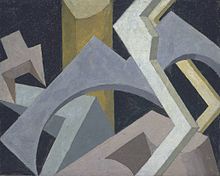Jessica Dismorr (3 March 1885 â€" 29 August 1939) was an English painter and illustrator and one of only two women members of the Vorticist movement.
Early life

Jessica Stewart Dismorr was born at Gravesend in Kent, and moved with her family to Hampstead in the 1890s. Her father, John Stewart Dismorr, was a rich businessman, as a consequence of which she was free of financial worries.
She attended the Slade School of Art, 1902â€"03, before training under Max Bohm at Etaples, and at the Académie de La Palette in Paris, 1910â€"13, where she studied under Jean Metzinger and was in the circle around the Scottish Colourist, John Duncan Fergusson. In 1911, she contributed several illustrations to Rhythm magazine.
Early exhibitions

Dismorr exhibited with Fergusson and S. J. Peploe in October 1912 at the Stafford Gallery, London, at the same time as Roger Fry's second Post-Impressionist show, in which they were not included.
In 1912 and 1913, she exhibited Fauvist influenced work in the Allied Artist's Association. An influence said to have resulted from her studies at La Palette.
Relationships

She met Wyndham Lewis in 1913. Robin Ody, a close friend and the executor of her will (in which all the beneficiaries were women), summed her up as "the Edwardian phenomenon of the new woman". She maintained a studio in the King's Road, Chelsea, London, as well as taking frequent trips to France. She also essayed into sexual freedom. Ody considered that she did not have a physical relationship with Lewis, one of the main reasons being her inclination towards her own gender. According to one of Lewis's lovers, Kate Lechmere, Dismorr had a difficult love affair with Wyndham Lewis, and was, along with fellow artist Helen Saunders, one of the "little lapdogs who wanted to be Lewis’s slaves and do everything for him". Lechmere gives this as the reason for Dismorr stripping naked in the middle of Oxford Street on one occasion.
In fact Saunders had twice turned down proposals from Walter Sickert, and in later life said that she thought it was not to the woman's advantage when two artists married, as she would inevitably relegate her own artistic needs below those of her husband's.
It must also be borne in mind that Lechmere's relationship with Lewis had ended bitterly, and she carried out a legal struggle to recover money owed her by him. Lechmere had provided all the funds to pay for the Rebel Art Centre, where the Vorticists first met in 1914â€"a fact which Lewis had to admit to Christopher Nevinson who had not wanted "any of these damned women" in the group.
Vorticism

Dismorr was a signatory to the Vorticist manifesto published in the first issue of their literary magazine, BLAST in 1914. She shared the group's depiction of the dynamics of the machine, but little of her work from this period survives. Apart from her, the only other female member of the group was Helen Saunders. William Roberts's painting The Vorticists at the Restaurant de la Tour Eiffel: Spring 1915, from 1961â€"62, shows the seven males dominating the foreground and the two women behind (Dismorr in the doorway being the furthest away).
She exhibited with the Vorticists again in New York in January 1917.
World War I

During World War I she was a nurse in France and then with the American Friends Service Committee. She had a nervous breakdown in 1920 following her war experiences. She received medical advice not to paint, but Lewis suspected that it was her modern style that was causing the doctors concern, and wrote to her that "the best possible distraction for you would be to paint".
She was at the centre of the London avant-garde world, acquainted with both T. S. Eliot and Ezra Pound, with her poems and illustrations being published, including in the Vorticist Blast magazine. In the 1930s she did portraits of poets, including Dylan Thomas and exhibited with Charles Ginner and Barbara Hepworth in the London Group, as well as with Ivon Hitchens and Ben Nicholson in the Seven and Five Society, having joined both these groups in 1926.
Later life

Throughout her life she continued painting and exhibiting her work, which became completely abstract during the 1930s. She contributed work to Axis magazine in 1937.
Dismorr committed suicide by hanging in London on 29 August 1939, five days before Britain declared war on Germany.
Quentin Stevenson is currently writing her biography. Catherine Heathcock's (unpublished) PhD thesis contains a complete catalogue of Dismorr's works. The letters between Dismorr and Lewis are now at Cornell University.
References and sources

- References
- Sources
- Richard Cork. "Dismorr, Jessica." Grove Art Online. Oxford Art Online. [1]. Retrieved 11 March 2009
Further reading
- Antcliffe, Mark, and Green, Vivien (eds.) (2011). The Vorticists: Manifesto for a Modern World. Tate Publishing. ISBN 978-1-85437-885-9.
- Cork, Richard (1976). Vorticism and Abstract Art in the First Machine Age. University of California Press. (2 vols.) ISBN 0-520-03154-7 & ISBN 0-520-03269-1.
External links
- An example of Dismorr's work at the Wayback Machine (archived December 26, 2004)
- Article by Mark Archer in the Financial Times, February 28, 2006 (accessed March 1, 2006)
- An example of Dismorr's Vorticist work at the Wayback Machine (archived February 22, 2006)
- 2 paintings and 4 drawings (including Dylan Thomas)
